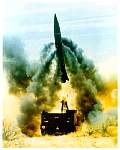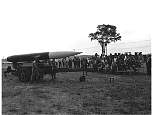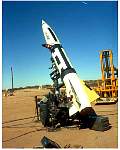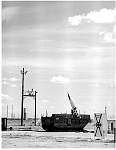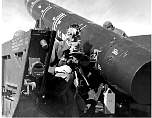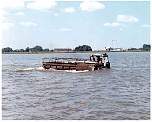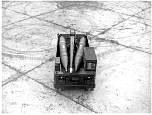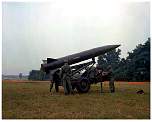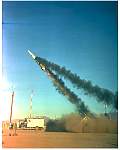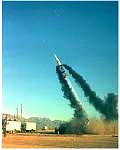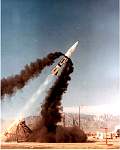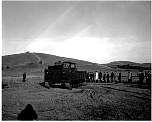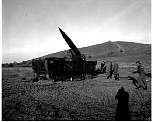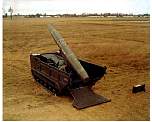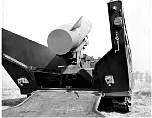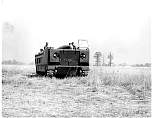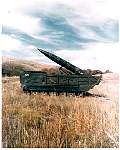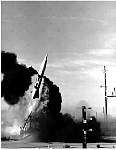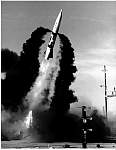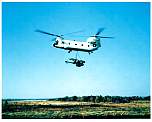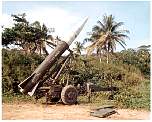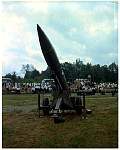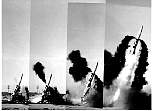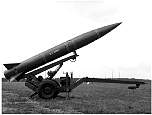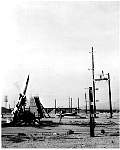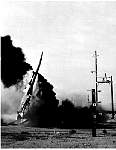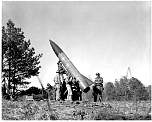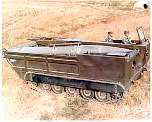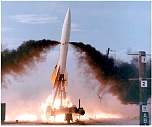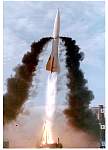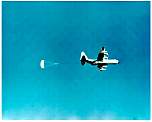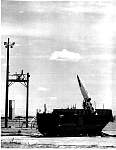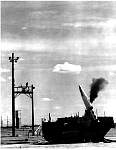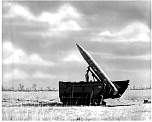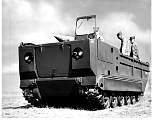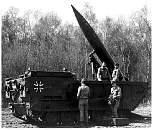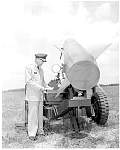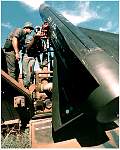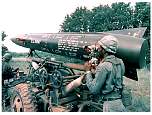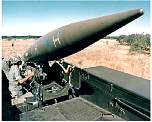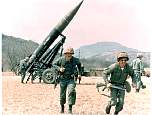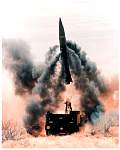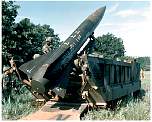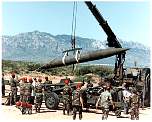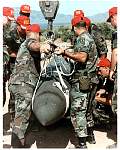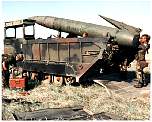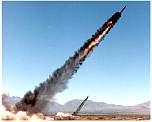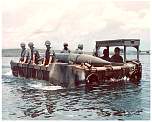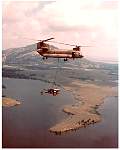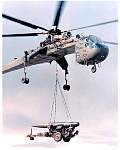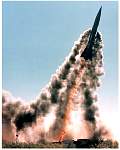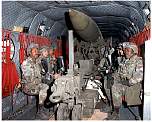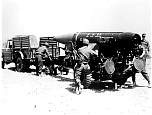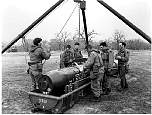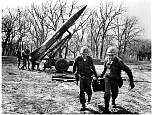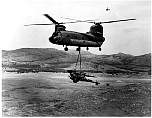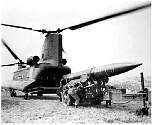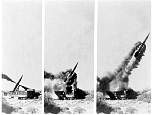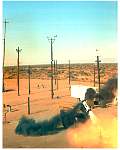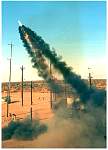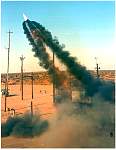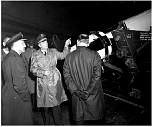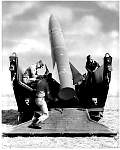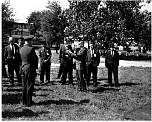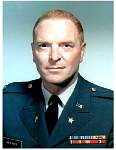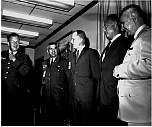Table of contents
System Chronology
LANCE Photos
Introduction
System Description
The LANCE was a mobile field artillery tactical missile system used to provide both nuclear and non-nuclear general fire support to the Army Corps. Designed to attack key enemy targets beyond the range of cannon artillery and to reinforce the fires of other artillery units, the LANCE replaced the HONEST JOHN system, fielded in 1954, and the SERGEANT system, deployed in 1962. It filled the U.S. Army's need for a highly mobile, medium-range, fin stabilized, all weather, surface-to-surface missile weapon system. The LANCE's primary mission targets included enemy missile firing positions, airfields, transportation centers, command and logistic installations, critical terrain features (defiles, bridgeheads, main supply routes, etc.), and large troop concentrations.
The missile was incrementally guided by a self-contained system using the Directional Control Automatic Meteorological (DCAM) Compensation concept. The LANCE missile was launched by a high thrust booster that propelled it out to 1500 meters. The boost phase direction was controlled by a gyro commanding secondary injection into the booster. The booster cut off and the variable thrust sustainer, controlled by an accelerometer, provided the exact amount of thrust to equal the missile drag. The result was a predictable trajectory that essentially eliminated errors caused by atmospheric disturbances or changes. The missile was aimed using field artillery techniques plus the variable booster time. Unlike other Army missiles that use solid propellants, the LANCE used a prepackaged, liquid fuel that eliminated any need for fueling in the field and gave the LANCE a short reaction time. It was capable of delivering nuclear warheads out to a range of about 75 miles and conventional warheads to a range of about 45 miles.
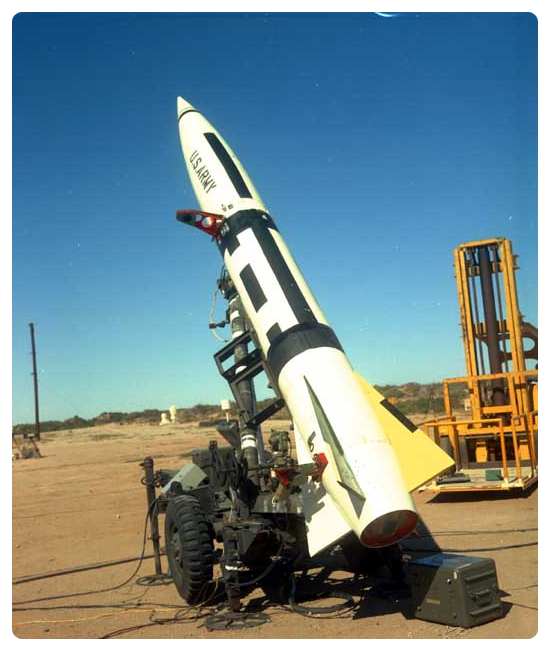
The missile system briefly gained notoriety as the "neutron bomb," after the Washington Post reported on the Army's development of a warhead for the LANCE that would kill people but cause minimal destruction of property. The enhanced radiation warhead was designed to release within a restricted radius great quantities of neutrons which attacked the human central nervous system. The warhead would also reduce the heat and blast effects of conventional nuclear warheads, thereby reducing the destruction of buildings and collateral damage to civilian populated areas. Officials believed that the LANCE enhanced radiation warhead would deter a Soviet attack by threatening the U.S.S.R. with a weapon that could be used without destroying the Federal Republic of Germany in order to save it. Congress approved production funds for the new warhead on 13 July 1977, but President Jimmy Carter deferred production of the neutron warhead in April 1978.
Project Management
Established under the U.S. Army Ordnance Missile Command (AOMC) as the Missile "B" Project Office on 11 December 1961, the subsequently renamed LANCE was one of the original project management offices created with the activation of the U.S. Army Missile Command (MICOM) on 1 August 1962. The LANCE Missile System development began when MICOM issued a letter contract to Ling-Temco-Vought (LTV), prime contractor for the system, on 11 January 1963. Four months later, on 24 May, MICOM definitized the original letter contract as a cost-plus-incentive-fee (CPIF) contract, the first ever applied to a major U.S. Army weapon system. This CPIF contract was also unique because it covered the entire research and development phase of the LANCE program, and was one of the first Army contracts "certified" for Program Evaluation and Review Technique (PERT)-Cost.
On 1 December 1970, the LANCE weapon system was elevated to a Class II activity assigned to U.S. Army Materiel Command (AMC) Headquarters, although it was still physically located at Redstone Arsenal (RSA). The project office returned to MICOM's jurisdiction on 1 August 1974.
The LANCE Project Office was terminated on 31 March 1980, and responsibility for the missile system transferred to the MICOM Weapon Systems Management Directorate (WSMD). Level II management of the system was subsequently provided by the MICOM Missile Logistics Center (later the Integrated Materiel Management Center) from July 1981 until FY 1992. Responsibility for the demilitarization and reuse of excess LANCE assets was transferred to the reestablished MICOM WSMD in FY 1993.
Development
A family of field artillery missiles designated "A" to "D" was proposed for development in the 1965-70 timeframe. Missile "B" was to deliver a 1000-pound nuclear, non-nuclear, or chemical warhead to a range of 75 kilometers. Accuracy was set at 5 mils to encourage a low unit cost of the missile. The technical approach of DCAM was a perfect fit. Dr. William C. McCorkle and Mr. R.G. Conard of the Ordnance Missile Laboratories (OML) at Redstone Arsenal invented the DCAM guidance system. This was the first and perhaps the only Army missile system based on an OML invention.
The feasibility of the Automet was demonstrated by an experimental Missile "A" using a constant thrust booster with a variable aerodynamic drag missile. Missile "B" required the development of a unique variable thrust liquid engine. The technical recommendations in June 1961 were that this new engine be demonstrated before proceeding with a Missile "B" development program. On 9 May 1962, the Department of Defense (DOD) directed that the prime contractor for the Missile "B" development program be selected by 1 October 1962. On 1 November 1962, the Army selected the LTV team in Dallas, Texas, to do the work in the Michigan Army Missile Plant (MAMP). At this time, Missile "B" was renamed LANCE.
LTV immediately started the total system development with emphasis on meeting the schedule incentive for the first flight. Three LANCE missile configurations were planned for the development program: Engineering Model (EM) for development; Tactical Prototype (TP) for transition to production; and Production Model (PM) for hardtooled production line.
By April 1964, serious problems with the propulsion system caused the LANCE Project Office and LTV to put a team on-site at the subcontractor, Rocketdyne. The team identified technical and management problems involving more than propulsion, and corrective action was taken. The missile length had to be increased to compensate for reduced engine performance, while the schedule-driven program was changed to an event-driven logic using "Quantified Milestones" (QMs).
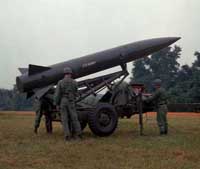
The first successful engine test occurred on 16 January 1965. The first flight test was conducted successfully on 15 March 1965. The LANCE DCAM concept was demonstrated by this flight, which experienced a 125-knot crosswind at apogee. Subsequent EM flights resulted in a test, fix, test approach. DOD moved LANCE from a Research and Development (R&D) category to one of General Purpose Forces in November 1965. The final block of six EM flight tests was completed successfully on 3 October 1966. The following month, recommendations for Limited Production (LP) were submitted to the Department of the Army (DA), which authorized LP procurement of 17 sets of ground support equipment (GSE) on 15 June 1967.
Studies in April 1965 showed that LANCE could extend its range to 75 miles by the use of a higher performance engine and larger fins, and by removing the ballast from the nuclear warhead. This meant that the Extended Range LANCE (XRL) could fill both the "B" and "C" missions. The Assistant Secretary of the Army (Research and Development) (ASA[R&D]) directed that the concept be demonstrated in time for an October 1966 XRL decision. Two experimental XRL missiles demonstrated the feasibility on 28 September 1966. DA approved development of XRL in March 1967. On 15 December 1967, the Secretary of the Defense directed that only the XRL configuration of LANCE be fielded.
The TP flight test program began in early 1967 with mixed results. The test program was halted on 20 October 1967 when the fifth TP missile blew up. A new diagnostic approach was developed to find the "Root Cause" of the failure. The failures were isolated to the most likely cause and the failure duplicated before the "Root Cause" was confirmed. Corrective action was then applied. The "Root Cause" of this failure was confirmed on 13 May 1968. The corrective action was appropriately known as SOS-Spring on Seal-to keep oxygen-rich gases from mixing with the hot, fuel-rich solid propellant gas generator gases. The new feed system was successfully flown on 30 August 1968 and subsequently certified by four more flights by March 1969.
The first XRL flight test was conducted successfully on 13 May 1969. However, on 11 July 1969, the XRL engine failed dramatically due to combustion instability. The diagnostic process was used to isolate the problem and then to direct the solution demonstrated on 24 October 1969. On 6 March 1970, the XRL maximum range and accuracy were successfully demonstrated. A senior In-Process Review (IPR) on 10 September 1970 recommended LP production of 75 missiles and cancelled the chemical warhead flights.
The first Engineering Test (ET)/Service Test (ST) failed on Friday, 13 August 1971. The "Root Cause" was a missile power interruption from the nuclear warhead. With corrective action, the flight tests continued until 30 November 1971, when a second nuclear warhead missile failed. This failure required a major redesign of the nuclear warhead circuitry. Another 12 missiles and 9 additional months were required to certify the redesign.
A Production Validation IPR held on 9 May 1972 recommended Type Classification Standard "A" (TC-STD-A) for the LANCE missile and an extension of the nuclear warhead LP quantities based on ET/ST results. Following a subsequent IPR, the nuclear warhead was declared TC-STD-A on 16 April 1973.
The non-nuclear warhead program progressed slowly due to a continuing problem with an XM41 munition high dud rate such that in the latter part of FY 1969 the standard M40 munition was explored for use with LANCE. On November 1971, Congress cancelled all funds for the non-nuclear warhead. A restart of the program was authorized in January 1973. By April 1974, 10 flight tests had been completed, but a redesign and retest of the main fuze was required. In 1976, the production go-ahead for 360 missiles was received.
Deployment and Demilitarization
LANCE missile production was approved in September 1970, and the first battalion was fielded to the U.S. Army, Europe (USAREUR) in September 1973. At that time, the system achieved its initial operational capability (IOC). Less than two years later, the first full-scale deployment of the LANCE to a foreign military sales (FMS) customer was accomplished. Once it was fully fielded, the Army had eight LANCE battalions, six in Europe and two in the United States. LANCE was also sold to NATO allies and to Israel in the non-nuclear version.
Originally scheduled to be retired in the mid-1980s, the LANCE system was extended through 1990. DA subsequently decided in June 1985 to extend the nuclear-only LANCE shelf life to 1995. However, on 27 September 1991, President George Bush announced a unilateral cut in nuclear weapons, which was followed on 5 October by a similar announcement by President Mikhail Gorbachev of the U.S.S.R. Although the Soviet Union collapsed shortly thereafter, the United States later reaffirmed this nuclear arms reduction agreement by signing a treaty with Russia, Belarus, Kazakhstan, and Ukraine on 23 May 1992. The final LANCE battalion stood down at Fort Sill, Oklahoma, on 30 June 1992. After being demilitarized, excess LANCE missiles were set aside for use as targets.
Postscript
The success of the LANCE program is keyed to the fact that LANCE was never fired in anger, and with the U.S./U.S.S.R. Treaty, tactical nuclear missiles have been dismantled, including LANCE. An unprecedented "world peace" followed that now provides hope for a viable future.
System Chronology 1956-1995
15 October 56 Original requirements for Missile "B" were first established in a Deputy Chief of Staff for Operations (DCSOPS) staff study.
19 August 58 Continental Army Command (CONARC) sent DA the qualitative materiel requirements (QMR) for Missile "B".
29 March 59 The Qualitative Development Requirements Information (QDRI) was released for Missile "B". Some 60 contractors responded to the request for feasibility studies.
May 61 The Directional Control Automet (DCAM) guidance system, invented by Dr. William C. McCorkle and Mr. R.G. Conard of OML, was a primary candidate for Missile "B". The concept was successfully demonstrated during this period by an experimental Missile "A" using a constant thrust propulsion and variable aerodynamic missile drag.
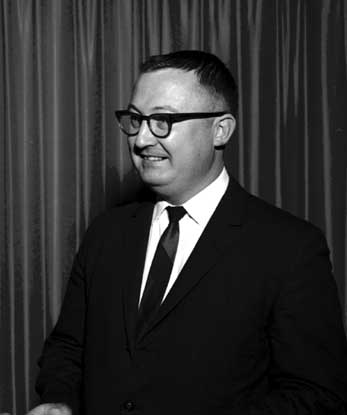
Dr. William C. McCorkle
June 61 The Army Ballistic Missile Agency (ABMA) recommended that a Missile "B" program be limited to a component demonstration of a variable thrust liquid engine. The Ballistics Research Laboratory (BRL) proposed a future artillery family: Missile "A" to replace the LITTLEJOHN; Missile "B" to replaced the HONEST JOHN; Missile "C" to replace the SERGEANT; and Missile "D" was the PERSHING.
5 July 61 The QMR for Missile "B" was approved. The requirement was to deliver a 1000-pound nuclear, non-nuclear, or chemical warhead to a maximum range of 75 kilometers with 5 mils accuracy.
11 December 61 The Missile "B" Project Office was established under AOMC.
9 May 62 DOD directed the Army to proceed with the development of Missile "B" by initiating 60-day program definition phase with the technical approach open. The prime contractor was to be selected by 1 October 62.
9 June 62 AOMC issued the Missile "B" request for quotation, asking for industry proposals covering the program definition and system development phases. The command recommended two contractors be used for the first phase.
16 July 62 Eight contractors submitted proposals for two technical concepts: DCAM and the Simple Platform Inertial (SPI).


Missile "B" proposals
1 August 62 Two contractors were selected for the 60-day program definition: Chrysler at MAMP and LTV at Dallas, Texas. DCAM was designated as the technical approach.
1 August 62 Missile "B" was established as one of the original MICOM project management offices.
COL William W. Holmes was designated as Project Manager (PM), and served until his retirement on 31 March 64.
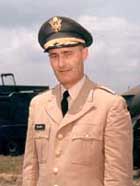
COL William W. Holmes
20 August 62 MICOM awarded 60-day program definition contracts to LTV and Chrysler.
19 October 62 Two prime contractor "Total Development Program" proposals were received. Army recommendations were submitted to DOD 10 days later.
1 November 62 AMC announced the selection of LTV as the prime contractor for Missile "B". It also selected MAMP as the site for work on the system.
26 November 62 DA officially renamed Missile "B" as LANCE. The name symbolized the cultural traditions of North American Native Americans. Only experience warriors were permitted to carry lances.
11 January 63 LTV received a letter contract to begin LANCE development.
24 May 63 The letter contract of 11 January 63 with LTV was definitized into a 5-year, $75-million CPIF contract. This was unique because the contract covered the entire research and development phase of the LANCE program. It was also the first CPIF contract applied to a major Army weapon system.
18-20 June 63 The Engineering Concept Review (ECR) milestone was successfully completed at RSA using full-scale mock-ups operated by troops.
September 63 Following the ECR, the lightweight launcher (LWL) requirement was changed from limited to full mobility. The Canadian government agreed to assume the development coast of the LWL ($1.75 million), and a subcontract was placed with Hawker Siddley, Toronto, Canada.
April 64 Serious problems with the liquid propulsion system caused LTV and the Lance Project Office to put a team on site at Rocketdyne. As a result, LTV had until 1 September 64 to get the LANCE program on a sound basis.
1 April 64
LTC Walter E. Mehlinger became the LANCE PM. He served until 11 June 67.
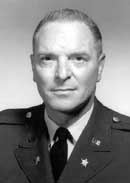
LTC Walter E. Mehlinger
10 April 64 DOD approved a Nuclear Warhead Phase III for the LANCE.
October 64 The LTV contract was modified to get the program on a sound basis by reducing the booster specific impulse, engine nominal thrust, and missile powered flight time. The missile would increase in length and weight. The impact on the program amounted to at least 6 months and $30 million.
16 January 65 The first successful full duration engine test was conducted.
18 February 65 The LANCE propulsion system captive test began.
15 March The first LANCE flight test was successfully conducted at White Sands Missile Range (WSMR). This was the first demonstration of the LANCE DCAM concept. It experienced a 125-knot crosswind at apogee.
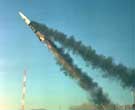
April 65 Studies showed that with a higher performance engine and larger fins, and by removing the ballast from the nuclear warhead, the LANCE's range could be extended to 125 kilometers (i.e., it would replace the SERGEANT and Missile "C"). The ASA(R&D) directed that alternate approaches be developed for an October 66 decision.
17 August 65 The fueling of LANCE missiles was assigned to Anniston Army Depot (ANAD), Alabama. Operations began on 1 May 67.
31 August 65 Operational tests under extreme environmental conditions demonstrated that LANCE could meet requirements.
23 November 65 DOD moved LANCE from Program IV (R&D) to Program III (General Purpose Forces) and approved part of the planned force structure.
1 December 65 The ASA (Installations and Logistics) approved a multi-year Determination and Findings (D&F) necessary to support the program through type-classification to include long lead tooling for the Production Model (PM).
March 66 New cost and schedule incentives were established for the LTV prime contract. Cost overruns and schedule delays invalidated the original incentive.
24-25 March 66 The LANCE Design Characteristics Review (DCR) was held at RSA. It was concluded that the design proposed for the Tactical Prototype (TP) was satisfactory, but QMR changes were recommended.
28 April 66 LTV's contract was changed to include the Extended Range LANCE (XRL) contract definition and feasibility demonstration program.
May 66 The LANCE Project Office and LTV established a memorandum of understanding (MOU) which defined selected milestones in terms of quantified performance logic required to complete the milestone. The Interim Release to Industry (IRI) was one of these.
28 September 66 Flight testing of two XRL demonstration missiles was completed. The feasibility of the XRL was confirmed.
3 October 66 The final block of six missiles successfully completed EM flight testing.
31 October 66 DOD selected a new nuclear warhead for LANCE. This put the warhead development about 1 year out of phase with the missile. A major recovery program was required to minimize the impact.
17 November 66 The LANCE PM submitted recommendations to AMC for the LANCE program based on the May 66 MOU with LTV.
24 March 67 DA approved the development of the Extended Range LANCE.
June 67 Tropic soak and operational tests were successfully completed at Fort Sherman, Canal Zone, Panama.

June 67 Two TP missiles were air dropped and subjected to ground mobility testing. One fired successfully, while the other exploded (similar to the 28 April 67 TP flight failure).
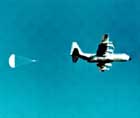
15 June 67 The LANCE PM presented the status of meeting the IRI milestone objectives to DA. DA authorized production of 17 sets of GSE.
31 July 67
COL Arthur F. Pottle, Jr., assumed responsibility for the LANCE project. He remained in this position until 1 August 70.

COL Arthur F. Pottle, Jr.
20 October 67 The LANCE program came to a stop when the TP-16 missile exploded, 20 seconds after lift-off. This was the fifth TP explosion. A new diagnostic approach-"Root Cause"-was developed, whereby the most likely cause of failure had to be identified and duplicated before the program could apply corrective action and proceed.
15 December 67 The Secretary of Defense decided to field only the Extended Range LANCE and discontinue development of the Basic LANCE. LTV's contract was modified on 17 July 68 to reflect this change.
May 68 LTV duplicated the cause of the TP-16 failure. The Spring on Seal (SOS) corrective action prevented gas from the oxidizer tank from blowing past the seal into the hot, fuel-rich gas of the solid propellant gas generator.
30 August 68The TP flight test was successful with the SOS feed system. Final certification based on five flights was completed in March 69.
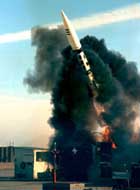
Flight Test, September 1968
10 December 68 The Secretary of Defense signed a program change decision approving the fielding of the LANCE with nuclear capability.
13 May 69 The first XRL engine flight test met all objectives.
11 July 69 An XRL engine failed due to combustion instability.
24 October 69 The XRL engine with the corrective action indicated by the "Root Cause" was successfully demonstrated.
6 March 70 A successful flight test validated the XRL tactical design at 125 kilometers within 3.5 mils accuracy.
30 July 70 COL Samuel C. Skemp, Jr., became LANCE PM. He served in this capacity until 21 December 70.
9-10 September 70 The Prototype Systems Characteristics Review, a senior IPR, recommended a LANCE program of 75 nuclear missiles and certain GSE, continued development of the non-nuclear warhead, and cancellation of the chemical warhead flight tests.
2 October 70 The Vice Chief of Staff of the Army (VCSA) approved the recommendations of the senior IPR.
1 December 70 The MICOM LANCE Project Office was elevated to a Class II activity assigned to AMC Headquarters, although it was still physically located at Redstone Arsenal.
21 December 70
COL (P) Rutledge P. Hazzard assumed responsibility as LANCE PM. Promoted to brigadier general on 3 May 71, he served until 1 June 71.

COL (P) Rutledge P. Hazzard
January 71 LTV received a contract for the first LANCE missile procurement. A unique warranty provision made the contractor responsible for any design change required to correct a performance deficiency at no cost to the government.
2 April 71 The AMC Commander, General Miley, came to MAMP for the government acceptance
of the first LANCE production model hardware.
See Detroit News article

1 June 71
COL (P) Robert J. Proudfoot became LANCE PM. He served in this capacity until 3 March 73. He was promoted to brigadier general on 1 January 72.

COL (P) Robert J. Proudfoot
13 August 71 The first Engineering Test/Service Test (ET/ST) flight failed after it impacted 2 to 3 kilometers from the launcher. "Root Cause" determined that a power interruption in the nuclear warhead programmer was the source of the failure.
30 November 71 Another ET/ST flight failed. An electronic malfunction in the nuclear warhead circuitry required a major redesign to correct. Nuclear ET/ST completion was delayed from March 72 to January 73 in order to flight test 12 additional missiles required to certify the new design.
December 71 Congress cancelled all funds for the development and procurement of a non-nuclear LANCE warhead.
9 May 72 The Development Acceptance/Production Validation Review, an IPR, found LANCE missile performance during ET/ST to be acceptable and recommended TC-STD-A for the missile. It also extended LP quantities for the nuclear warhead.
26 May 72 DA approved type classification Standard A for the LANCE missile. It also approved production of the system to meet overseas deployment.
29 June 72 The MICOM Materiel Release Review Board (MRRB) approved the conditional release of the LANCE system for training.
30 June 72 The first LANCE training battalion was activated at Fort Sill, Oklahoma.
January 73 The AMC Commander authorized the LANCE PM to restart development of the non-nuclear warhead since funds were available.
3 March 73 COL Hal C. Bennett, Jr., was named acting PM for LANCE and served until 2 April 73.
2 April 73
COL (P) George E. Turnmeyer became LANCE PM and served in this capacity until 1 August 74. He was promoted to brigadier general on 29 April 73.

COL (P) George E. Turnmeyer
13 April 73 The Development Acceptance/Production Validation IPR for the extended nuclear warhead program took place at RSA and recommended TC-STD-A for the nuclear warhead adaption kit. DA approved this recommendation on 23 April 73.
23 May 73 Equipment (pdf) for the first LANCE overseas battalion was shipped to Germany.
September 73 The first LANCE battalion-the 1st Battalion, 333d Field Artillery-was deployed overseas, achieving IOC for the system.
April 74 The XM251 non-nuclear warhead completed 10 development flights. The XM811E5 fuze had to be redesigned, delaying Development Test II/Operational Test II (DT II/OT II) for 3 months.
1 August 74 The Office of the PM for LANCE was returned to MICOM's jurisdiction.
1 August 74
COL Grayson D. Tate, Jr., became LANCE PM. He remained in this position until 1 October 75.

COL Grayson D. Tate, Jr
March 75 The first full-scale deployment of the LANCE system to a foreign military sales (FMS) customer (Italy) was accomplished.
30 June 75 Because of a shortage of Unsymmetrical DiMethal Hydrazine (UDMH), 300 LANCE missiles remained unfueled. Limited DOD allocations plus a LANCE spill at ANAD caused a backlog that was not resolved for 2 years.
September 75 LANCE deployment in USAREUR was completed. A total of 6 LANCE battalions replaced 4 SERGEANT and 14 HONEST JOHN battalions.
1 October 75 LTC (P) Donald P. Whalen assumed the position of LANCE PM. Promoted to colonel on 1 February 76, Whalen remained LANCE PM until 1 July 78.
November 75 The eighth LANCE battalion, originally scheduled for Korea, was activated at Fort Sill and designated as a Strategic Forces Battalion.
December 75 A Velocity Control Electronics (VCE) capacitor networks failure revealed that the supplier had changed the design without requalification or notification. A total of 223 faulty units were delivered. Recovery required 15 months.
1976 The U.S. non-nuclear LANCE program received production go-head.
30 September 76 FMS total sales of LANCE by this date amounted to 10 battalions, 76 launchers and 903 missiles. Italy, the United Kingdom, the Federal Republic of Germany, Israel, Belgium and the Netherlands participated.
29 October 76 LTV received a contract to produce 360 non-nuclear missiles.
6 June 77 The new LANCE nuclear warhead-the enhanced radiation warhead-received widespread publicity as the "neutron bomb." The Washington Post reported that the weapon was designed to kill people, but would cause only minimal destruction of property.
13 July 77 Congress approved production funds for the enhanced radiation warhead, but the decision to produce had to be made by the president.
September 77 Analysis of U.S. and FMS tests showed that the accuracy and reliability of the LANCE system was equal to or better than the system requirements.
1978 This was the last full production year for LANCE missiles and non-nuclear warhead sections.
1978 The rebuild of LANCE vehicles began at Mainz Army Depot (MZAD) in Germany and ANAD.
7 April 78 President Jimmy Carter decided to defer production of the "neutron bomb" pending a final decision on its manufacture and deployment.
May 78 Deployment of the non-nuclear LANCE began.
31 July 78 COL Howard Jelinek became LANCE PM. He remained in this position until 31 March 80.
1 August 78 A stockpile retrofit was completed to correct the excessive accelerometer drift recorded in 1976. The retrofit extended LANCE's shelf life from 4 to 13 years.
31 March 80 MICOM requested and the U.S. Army Materiel Development and Readiness Command (DARCOM) approved the termination of the LANCE Project Office effective this date. Responsibility for the LANCE transferred to the MICOM Weapon Systems Management Directorate (WSMD).
September 80 Deployment of the U.S. non-nuclear LANCE was completed.
1 October 80 LANCE operations at MAMP were closed, and the plant was transferred to the U.S. Army Tank and Automotive Materiel Readiness Command (TARCOM). Tooling for LANCE repair parts moved to LTV, Dallas. Fueling operations at ANAD were also closed.
5 July 81 MICOM activated its Missile Logistics Center (MLC). Previously, WSMD had provided Level II management for the LANCE missile system. This responsibility transferred to MLC's Fire Support Management Office after the new organization was established.
10 August 81 President Ronald W. Reagan authorized the production of the "neutron bomb" as a warhead for missiles and artillery, reversing the policy set by President Carter. The weapons were to be kept in the United States.
7 April 82 The MICOM Commander approved a full release for issue of the LANCE Improved Gunner's Sight Unit. The new sight was designed to simply gunner firing operations, reduce maintenance and training requirements, and improve the reliability and accuracy of the missile system.
9 September 82 An MOU between USAREUR and MICOM was finalized on this date, approving the NATO Maintenance and Supply Agency (NAMSA) for backup support of selected items on the LANCE and TOW missile systems deployed in Europe.
November 82 Deployment of and training for the Improved Gunner's Sight in USAREUR was completed.
FY 84 The LANCE system was extended through 1990. Ground support equipment and other changes were made to support the extension of the missile's shelf life.
June 85 DA decided to extend the nuclear-only LANCE shelf life to 1995.
June 89 The LANCE reached the 1000th-missile fired plateau when Federal Republic of Germany troops fired the milestone missile during a flight test at the NATO Missile Flight Installation in Crete, Greece.
August 91 AMC held a conference to plan retrograde/demilitarization options on the LANCE missile.
27 September 91 President George Bush announced a large unilateral cut in nuclear weapons. All tactical weapons in Europe and Asia as well as on ships would be eliminated. In addition, long-range bombers and intercontinental missiles would no longer be on a 24-hour alert status. A similar reduction was announced on 5 October 91 by President Mikhail Gorbachev of the U.S.S.R.
1 February 92 The end of the Cold War was proclaimed in Washington by President Bush and President Boris Yeltsin of Russia.
23 May 92 The United States signed an agreement with Russia, Belarus, Kazakhstan, and Ukraine to abide by the nuclear arms reduction treaty negotiated with the U.S.S.R. before its collapse late in 1991.
30 June 92 The final LANCE battalion stood down at Fort Sill, Oklahoma.
FY 93 In response to the aforementioned nuclear arms reduction treaty, the LANCE was demilitarized and reassigned for use as a target. Responsibility for the system transferred from the MICOM Integrated Materiel Management Center (IMMC) to WSMD.
July 95 The LANCE demilitarization program was completed at Bishopton, Scotland. Several excess LANCE missiles were set aside for use as targets, resulting in significant cost avoidances for other customers.
LANCE Photos


